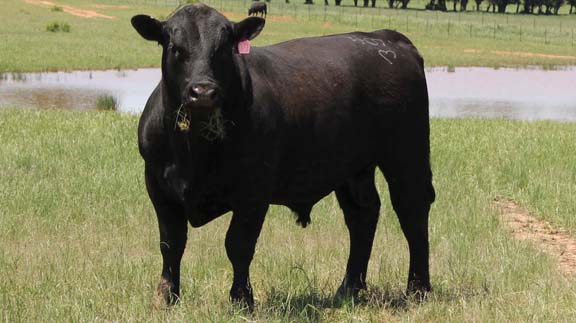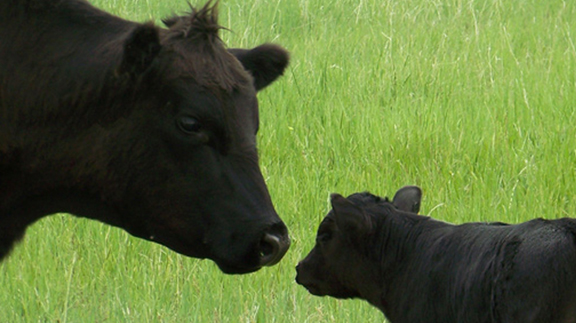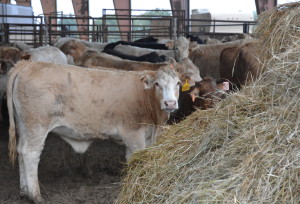Farm & Ranch
[AgriLife Today] Marketing options for cattle discussed at Blackland Income Growth Conference

By: Blair Fannin
Writer: Blair Fannin, 979-845-2259, [email protected]
Contact: Dr. Jason Banta, 903-834-6191, [email protected]
WACO – From traditional livestock auctions to online sources, cattle producers have a variety of options to choose from when marketing cattle, according to a Texas A&M AgriLife Extension Service beef cattle specialist.
Dr. Jason Banta, Texas A&M AgriLife Extension Service beef cattle specialist, said the biggest impact on income in a cattle operation is percentage of calves weaned. Other pieces of the equation include how many pounds the calves weigh and price received per pound. (Texas A&M AgriLife Extension Service photo by Blair Fannin)
Dr. Jason Banta, beef cattle specialist at the Texas A&M AgriLife Research and Extension Center in Overton, gave a broad overview of marketing options at the recent Blackland Income Growth Conference in Waco.
Banta said the biggest impact on income in a cattle operation is percentage of calves weaned. Other pieces of the equation include how many pounds the calves weigh and price received per pound.
“Condition of cows at calving time has the biggest impact on pregnancy rates,” Banta said. “You want those cows to be at a body condition score of five or better.”
Genetics also play an important role as well as input costs. Cull cows and cull bulls account for 10 to 15 percent of producers’ income.
“There’s value in these animals, and we need to market these animals to maximize the value,” Banta said.
There are several marketing channels, such as traditional livestock auction markets and online sources where a producer can post a classified ad.
For feeder calves and stocker cattle, Banta said producers can use livestock auction markets or sell through special preconditioning sale venues.
“You’d be surprised how far you can haul some cattle and get them into a preconditioning sale. The key is to go with one that has a good reputation to capture that premium.”
There are also video auction services as well as having someone come to your ranch and buy direct.
Dr. Jason Banta, beef cattle specialist at the Texas A&M AgriLife Research and Extension Center in Overton, gave a broad overview of cattle marketing options at the recent Blackland Income Growth Conference in Waco. (Texas A&M AgriLife Extension Service photo by Blair Fannin)
“Out of all of these options, it has to fit your operation and knowledge base,” he said.
When using auction markets, producers who have 15 to 30 better quality calves can call the barn ahead of time so the barn can advertise and help better market the calves.
“Some will let you pull tags early,” Banta said. “This is a good way to get a group of calves you have and sell them together before buyers who might be looking for a good group. They like this instead of having to pick them out one by one throughout a sale day or at multiple sales.”
Factors affecting the selling price of calves include color. Banta advised against producing calves with spots or paint colors. However, replacement females with stripes, such as a Braford cross, will bring a premium.
“We sell cattle on perceived breed type,” he said. “There are significant discounts if you have more influence of a breed that is not wanted by order buyers.”
Recommendations include no more than one-quarter Bos Indicus, at least one-quarter British and no more than one-half Continental.
“The industry wants medium to large frame cattle,” he said.
Banta said time of year can also affect prices paid. Spring typically brings some of the higher prices for weaned calves and cull cows, while fall will bring the lowest since many cattle operations are selling at this time.
-30-
Find more stories, photos, videos and audio at http://today.agrilife.org
Farm & Ranch
Hazards of Backyard Poultry

By Barry Whitworth, DVM
Having backyard poultry is a popular agriculture enterprise. According to the United States Department of Agriculture, 0.8 percent of all households in the United States have chickens. People keep chickens for a variety of reasons with table eggs being one of the more common reasons.
Unfortunately, some of these poultry producers are not aware of the hazards that come with keeping poultry because many times they carry pathogens but appear healthy.
Chickens are carriers of several zoonotic diseases. These are diseases that can be passed from animals to humans. According to a recent survey in Pennsylvania, a majority of backyard poultry producers were aware of the dangers of avian influenza. However, this study also revealed that far fewer producers were aware of the risk of possible exposure to Salmonella and Campylobacter.
The lack of knowledge about the hazards of raising poultry likely contributes to the continued issues of Salmonella outbreaks associated with backyard poultry. In 2023, the Centers for Disease Control and Prevention reported 1,072 illnesses of Salmonella linked to backyard poultry, and 272 of those patients required hospitalization. Oklahoma reported 43 individuals with the disease.
To read more, pick up a copy of the April issue of NTFR magazine. To subscribe by mail, call 940-872-5922.
Farm & Ranch
Ag Elsewhere: Wyoming

By Tressa Lawrence
Babies are tucked away in every nook and cranny. Many ranchers across Wyoming have baby animals popping up all over this time of year.
Farm & Ranch
Ag Elsewhere: Montana

By Lindsey Monk
Another load of grain in to keep feeding the calves until the green grass can really start popping.
-

 Country Lifestyles1 year ago
Country Lifestyles1 year agoScott & Stacey Schumacher: A Growth Mindset
-

 Equine7 months ago
Equine7 months agoThe Will to Win
-

 Country Lifestyles7 years ago
Country Lifestyles7 years agoStyle Your Profile – What your style cowboy hat says about you and new trends in 2017
-

 Country Lifestyles4 years ago
Country Lifestyles4 years agoAmber Crawford, Breakaway Roper
-

 HOME7 years ago
HOME7 years agoGrazing North Texas – Wilman Lovegrass
-

 Country Lifestyles7 years ago
Country Lifestyles7 years agoDecember 2016 Profile, Rusty Riddle – The Riddle Way
-

 Country Lifestyles8 years ago
Country Lifestyles8 years agoJune 2016 Profile – The man behind the mic: Bob Tallman
-

 Outdoor9 years ago
Outdoor9 years agoButtercup or Primrose?








